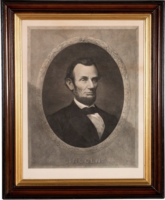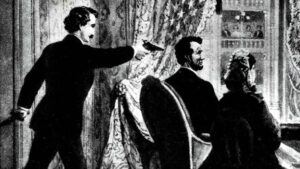
President Abraham Lincoln
The year was 1863, and then President Abraham Lincoln issued his now infamous “Emancipation Proclamation.” The question remains, just whom did Lincoln emancipate. Technically, although he “set free” the slaves in the South, he had no authority to do so, as the Confederacy had declared itself a sovereign nation in 1861. As with our politicians of today, this seemed to be more a political ploy than anything else. By 1863, we can assume that Lincoln was already running for reelection. Hmmmmm … this sounds familiar.
Since making the decision to publish a series of books some years ago, I have been finding more authors on the internet writing of similar thoughts.
The first of course, was Thomas DiLorenzo, in his 2003 book; The Real Lincoln: A New Look at Abraham Lincoln, His Agenda, and an Unnecessary War, with a forward by noted Black conservative columnist, Walter E. Williams.
The War between the States settled by force whether states could secede. Once it was established that states cannot secede, the federal government, abetted by a Supreme Court unwilling to hold it to its constitutional restraints, was able to run amok over states’ rights, so much so that the protections of the Ninth and Tenth Amendments mean little or nothing today. Not only did the war lay the foundation for eventual nullification or weakening of basic constitutional protections against central government abuses, but it also laid to rest the great principle enunciated in the Declaration of Independence that “Governments are instituted among Men, deriving their just powers from the consent of the governed.”
The Real Lincoln contains irrefutable evidence that a more appropriate title for Abraham Lincoln is not the Great Emancipator, but the Great Centralizer. ~ Walter E. Williams
On January 5, 2013, Andrew O’Hehir, writing for the web-blog, Salon in his column, Welcome to the new Civil War stated:
 You can’t boil one of the most tumultuous periods of American history down to one paragraph, but here goes: Lincoln was assassinated by a domestic terrorist and replaced by Andrew Johnson, who was an incompetent hothead and an unapologetic racist. Within a few years the ambitious project of Reconstruction fell victim to a sustained insurgency led by the Ku Klux Klan and similar white militia groups. By the late 1870s white supremacist “Redeemers” controlled most local and state governments in the South, and by the 1890s Southern blacks had been disenfranchised and thrust into subservience positions by Jim Crow laws that were only slightly preferable to slavery.
You can’t boil one of the most tumultuous periods of American history down to one paragraph, but here goes: Lincoln was assassinated by a domestic terrorist and replaced by Andrew Johnson, who was an incompetent hothead and an unapologetic racist. Within a few years the ambitious project of Reconstruction fell victim to a sustained insurgency led by the Ku Klux Klan and similar white militia groups. By the late 1870s white supremacist “Redeemers” controlled most local and state governments in the South, and by the 1890s Southern blacks had been disenfranchised and thrust into subservience positions by Jim Crow laws that were only slightly preferable to slavery.

Doctor Lincoln’s New Elixir of Life – For the Southern States
In February 2013, News With Views contributing writer, Dennis Cuddy began publishing his multi part series entitled, “Lincoln.” This however was more a review of the Steven Spielberg film of the same name, and yet the author succinctly and craftily wound his interview around the then topic of the day; the terrorist attacks in Benghazi on September 11, 2012. In his column, Cuddy stated:
Lincoln is primarily known for being the president during the Civil War and for freeing the slaves. The true story, though, is more complicated than most realize. Most people think the Civil War was fought over the existence of slavery in the United States, but it was not. In fact, it was fought over the issue of secession from the Union, and Lincoln once wrote a letter to a man saying that if he could preserve the Union without freeing a single slave, that is what he would do!
Cuddy concluded his February 4th column with the following:
The real instigators of the Civil War were the Power Elite (PE), led by the British. In THE PRESENT ATTEMPT TO DISSOLVE THE AMERICAN UNION: A BRITISH ARISTOCRATIC PLOT (1862), one can see a March 13, 1809 letter from British Emissary John Henry in Boston referring to the desirability of separating the states within the United States, and saying that “cannot be effected but by a series of acts and a long-continued policy tending to irritate the Southern and conciliate the Northern people… It would forever secure the integrity of his Majesty’s possessions on this continent.” The abolition of slavery would be one of those issues that would “irritate” the South. And in a March 15, 1861 letter from U.S. Minister to Vienna John Lothrop Motley to his own mother, Motley described a plot to divide the United States into North and South, with the Confederate states joining with Mexico, Central America, Cuba and other islands “to establish a great Gulf (of Mexico) Empire.”

Frederick Douglass
Days later, in her February 10th column, Against the Ghetto Plantation for American Thinker, Jeanne Donavan began her column by stating:
If Frederick Douglass walked today’s ghettos, he would witness a new-age style of slavery, plantations without the lash and chains. He would soon be outraged that government overseers are perpetuating generations of dependency through policies designed to capture the votes of the ignorant. Of the people he would ask, “What have you done with your freedom? Where is your dignity and self-respect?”

Thaddeus Stevens
We have oft been told that, after the civil war, the south was in ruins, the economy was destroyed, and the people defeated. Congress soon made three new amendments: the 13th, which ended slavery once, and for all, because the emancipation proclamation had no real power in government; The 14th amendment, which granted rights to all people, that couldn’t be taken away by the states; and the 15th amendment, which granted the right to vote to all adult males in the country. Soon after the end of the war a group of radical republicans, led by Thaddeus Stevens urged the north to send soldiers to the south, and they did. The soldiers helped the south get back on its feet, and made sure they wouldn’t rebel again. They also enforced the new amendments to the constitution.
An organization called the freedman’s bureau gave food, education, and clothing to the recently freed slaves, and others, to help them to help them on their feet.

Jeffrey Bennett ~ Author
President Johnson disagreed with the radical republicans, and found them a nuisance, especially their leader, Thaddeus Stevens, who tried to impeach Johnson. Stevens also wanted to give freed slaves small plots of land, so they could start becoming part of the economy, instead of making them having to resort to the same work they did as slaves.
Some of that, which you have read in the previous three paragraphs immediately above, is full of a certain amount of malarkey – or to put it more succinctly in modern language – B.S. It is through the continued chapters of Words and Deeds we will study the era of Reconstruction and Beyond – and it’s effects on America as a whole.
Oh – and from a personal Point of View – go read My history with Stinkin’ Lincoln.
As I write this chapter, we are over 160 years since Lincoln’s proclamation; yet what freedom do we have?
Who has been set free?
Who has been enslaved?

AFTERWORDS: The above was written by me after I had published Books I and II of what was to be a five volume set of AMERICA ~ The Grand Illusion. Volume I, “Orphans of the Storm” covered the time period from 1215 to 1826, and Volume II, “What God Has joined…” covered the time period from 1772 to 1865. The basis for these books in many respects, is what our category, Words and Deeds is intended to recreate. I have a long way to go to continue this project. ~ J.B.
